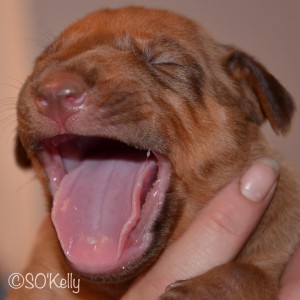Loss of an intact tooth: On very rare occasions, say as the result of rough play, an accident, fight or even just getting caught up in something, complete loss of an intact tooth can occur – although it is fairly unusual in dogs.
Should you find yourself in this position and you are able to retrieve the tooth immediately, it should be placed in milk and the dog taken to the vet as soon as possible.
It MAY SOMETIMES be possible to replace the tooth. In most cases, however, the loss of the tooth will be accepted and will cause the dog no problems at all.
As in humans, dogs are born without any teeth.

By about the age of 7 months, most dogs should have their full set of permanent (adult) teeth. In some smaller breeds it is quite common for dogs to retain some of the primary (milk) teeth but, if this causes problems for the dog with overcrowding for example, these should be removed by your vet. A full set of adult teeth should total 42 as follows:
The Upper Jaw –
your dog should normally have:
3 incisors on each side
1 canine tooth on each side
4 premolars on each side
2 molars on each side
The Lower Jaw –
your dog should normally have:
3 incisors on each side
1 canine tooth on each side
4 premolars on each side
3 molars on each side
Incisors:
These teeth are designed for nibbling and grooming the dog’s fur
Canines:
These teeth are designed for tearing flesh from bone
Premolars & Molars:
These teeth are designed to shear the food swallowable portions
It is important to pay attention to your dog’s dental hygiene and ensure that there is no build up of tartar on the tooth which may lead to gum disease (bad breath is often a sign of poor oral hygiene). Often the diet you choose to feed your dog can play a big part in the health of their teeth – brushing your dog’s teeth is a great way of ensuring these problems do not develop. If you do notice that your dog developed tartar build up on his teeth, a visit to your vet can determine whether he may need to have this removed with a “scale and polish”!

